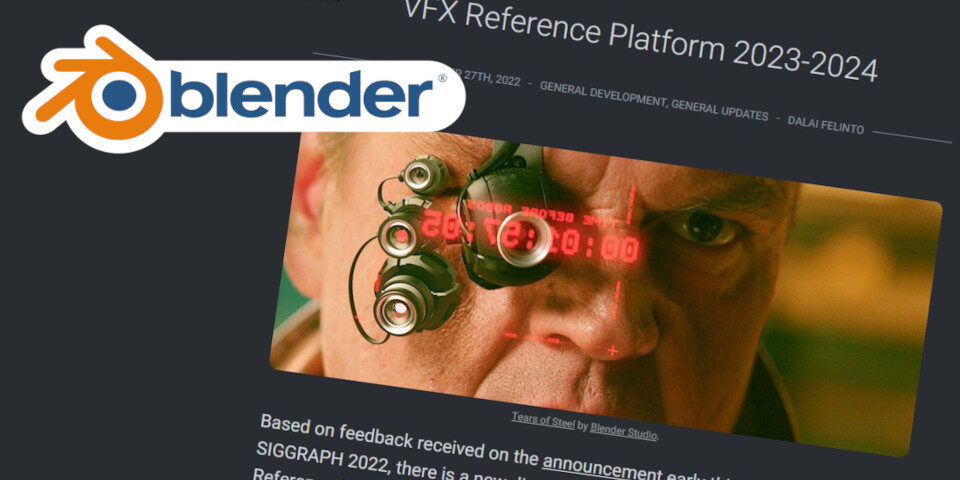Blender will no longer ditch the VFX Reference platform

The Blender Foundation has reversed its decision to stop following the VFX Reference Platform in Blender, following criticism from artists working in the visual effects industry.
All releases of the open-source 3D software in 2023 and 2024 will be fully compatible with the platform, while a new build option makes it possible to compile the current Blender 3.3 Long-Term Support release in a way compatible with the VFX Reference Platform’s 2022 specification.
A common standard for developing software for use in VFX pipelines
Launched in 2014 and overseen by the technology committee of the Visual Effects Society, the VFX Reference Platform is a common target for building software for the visual effects industry.
The annually updated specification sets out which versions of common components – including Linux compiler gcc, programming language Python, file formats like FBX and Alembic, and data interchange standards like OpenColorIO – that applications intended for visual effects pipelines should use.
It was introduced to reduce the problems that VFX studios – most of which use a wide range of software – face in trying to ensure that applications work correctly with one another, and with in-house tools and scripts.
Most major commercial software developers, including Autodesk, Foundry and SideFX, release updates compliant with the specification – albeit sometimes with previous versions, not the spec for the current year.
Decision to ditch the standard motivated by a desire to use newer versions of Python
In February this year, the Blender Foundation announced on its blog that Blender – which had previously also followed the specification – would no longer support the VFX Reference Platform.
It said that the decision to follow the platform had been made on the basis that it would encourage large studios to adopt Blender in production, and that it would encourage those studios to contribute to the development of Blender, but that “during the past two years there was little evidence of … those outcomes”.
The Foundation also said that the following the spec – which sometimes does not include the latest versions of components, to reduce the likelihood of studios having to update during the course of a long production – was slowing down development of Blender for other users.
According to the blog post: “For us [following the VFX Reference Platform] was perceived as a limitation, with users lacking benefits such as the latest Python version in Blender.”
Move would harm adoption of Blender in VFX studios, artists claimed
The post elicited a lot of detailed – and largely negative – feedback, including comments from staff and former staff at major visual effects studios like Animal Logic and Industrial Light & Magic.
Several noted that it takes longer than two years to switch a studio pipeline over to a new application, and suggested that use of Blender within the VFX industry was greater than the Foundation’s blog post implied.
According to one anonymous VFX supervisor with experience at major studios: “Blender’s reach into the VFX industry has exploded over these past two years. Every single company I have worked for has used Blender in one form or another, and so do the freelance artists we hire.”
Commenters also pointed out that in complex VFX pipelines with large numbers of dependencies, the decision to adopt, say, a new version of Python has knock-on effects far beyond supporting the new version of Blender itself.
Several said that the decision not follow the VFX Reference Platform would stop their studios from adopting new versions of Blender.
Blender now back to full compliance with the VFX Reference Platform until at least 2024
Those comments seem to have been representative of the feedback that the Blender Foundation has received from the VFX industry as a whole, since it has now reversed that decision.
In its latest blog post, the Foundation says that “based on feedback received on the announcement … and at SIGGRAPH 2022”, Blender will revert to full compatibility with the VFX Reference Platform in 2023 and 2024.
If the Foundation maintains its current two-year release cycles, that would take the software through the current 3.x releases and into the 4.x releases.
Although the official binaries of Blender 3.3, the current Long-Term Support release, are compiled with Python 3.10, a new build option in the release branch of the code makes it possible to compile the software with Python 3.9, in line with the VFX Reference Platform’s CY2022 spec.
Updated 30 September 2022: In the commments to the latest blog post, Blender development coordinator Dalai Felinto replied to the question, ‘Does this mean there won’t be official Blender 3.x builds that support Python 3.9?’ with “That’s correct. For now anyways.”
Re-adoption of the standard may help to foster development of Blender Hydra render delegates
According to the Foundation’s blog post, “besides helping studio integration, [reverting to the full specification] facilitates ongoing development to integrate Hydra render delegates with Blender”.
Current examples of such development include AMD’s USD Hydra plugin for Blender, which makes it possible to use RenderMan and AMD’s own Radeon ProRender as viewport renderers within Blender, and work to make Blender’s own Cycles renderer available as a viewport renderer in DCC apps like Houdini.
The current position on supporting the VFX Reference Platform fully within Blender is due to be reviewed in Q3 2024, with the Blender Foundation’s blog post setting out the ways in which users can submit feedback.
Read the Blender Foundation’s announcement resuming support for the VFX Reference Platform
